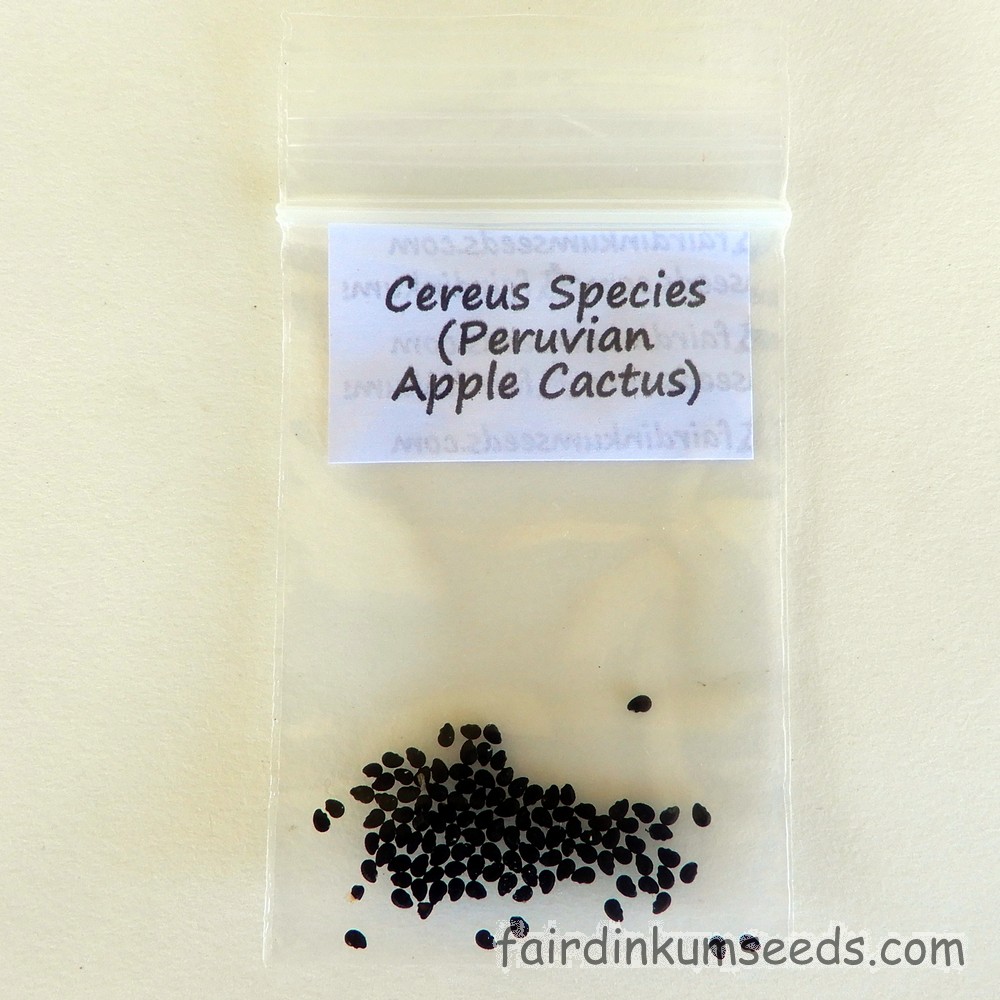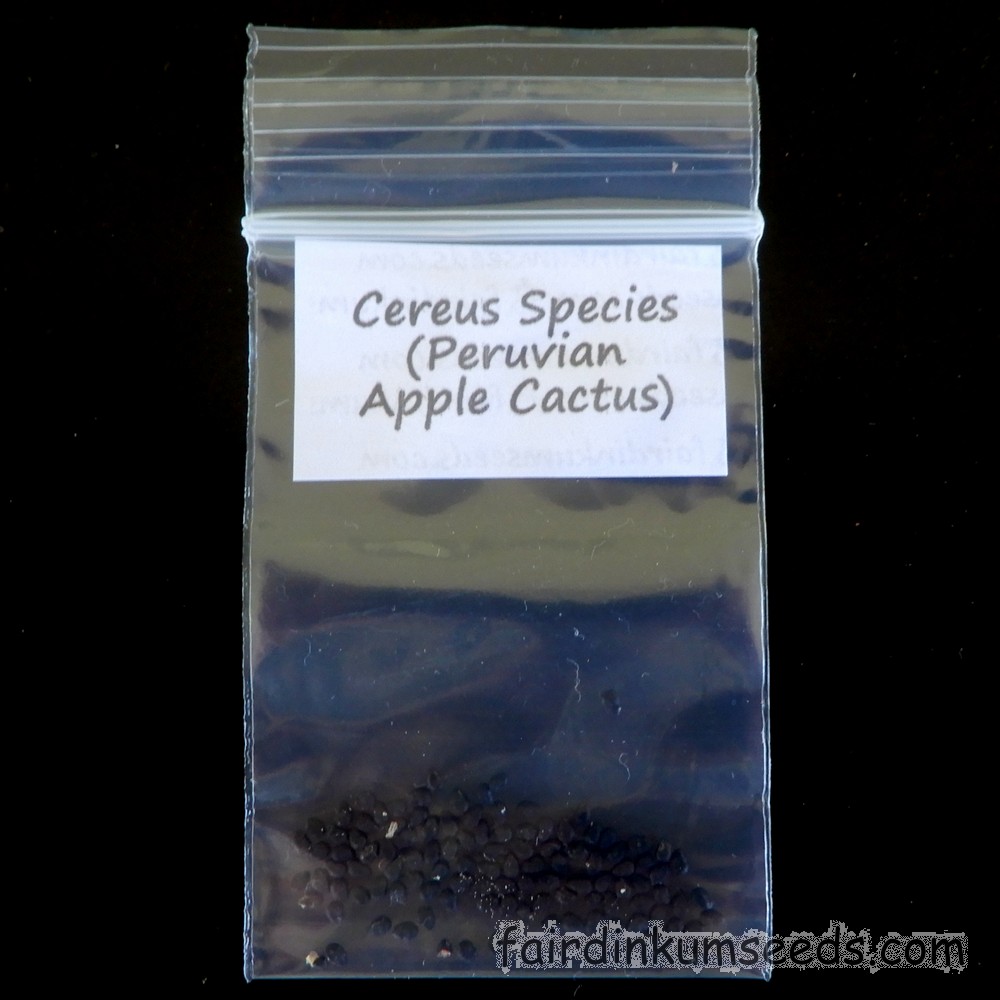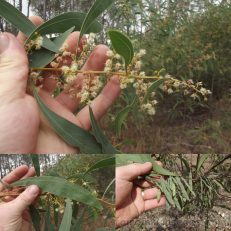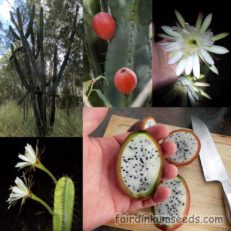Please read text!
Cereus Species Peruvian Apple Cactus Seeds
Packet of 75+ home grown seeds!
!!EDIT!!
I’m way too lazy to write a whole new advert but it is now many years later my Cereus collection is getting pretty massive, and as such the seeds you get in this packet are from a huuuuuge range of plants.
Short spines, long spines, variegated, monstrose, spiral growth, yellow skinned, purple skinned, red skinned, pure white flesh, pale pink flesh, pale yellow flesh, perfume and flowers tasting, banana flavoured, kiwi flavoured, melon flavoured, I have bloody 100’s of them of in every form I could get my hands on from growers all over the world(If you have orange or dark red or dark purple please hit me up as I would love to add them to the collection too!).
This packet of seeds is a real mix of everything and only the best of the best make the cut.
I better start by saying that I am not certain of the exact species, and I am unlikely to ever be.
I am labeling it as Peruvian Apple Cactus as that is the most commonly used name given to it by other commercial sellers of this fella.
I was advised by heaps of folks to just give it the botanical name of “Cereus peruvianus” as that is the name most commonly given to this plant by other sellers.
But, the thing is, Cereus peruvianus isn’t a valid botanical name…
That mob are all now considered to actually be Cereus repandus.
So it’s definitely not Cereus peruvianus, and it turns out it’s probably not even Cereus repands either, as it has deeper notches from the areoles, less ribs and less, shorter spikes, or in many cases no spines at all.
This means it(along with most other Cereus peruvianus commonly sold here in OZ) are most likely actually Cereus jamacaru or hybrids of it!
Cereus jamacaru was brought to Australia back in the day for it’s edible fruit and because it’s huge branches make a very productive animal feed.
They produce kilos of plant matter from a very small area, needing very little water, and they thrive in very poor rocky soils making them a much more productive choice than grasses or grain crops.
Many spineless lines were trialed as fodder over the years.
Before you ask, no, this definitely isn’t the nasty prohibited prickly pear cactus.
Those are Cactaceae like these guys, but they are all from the Opuntia genus while this fella is a Cereus species for sure.
Anyway, the various cacti experts I have contacted all tell me that identification of any cultivated forms of Cereus species is difficult if not impossible outside of their natural range.
This is because the millions of hybridized forms selected for certain traits means some individuals plants look very much like species that they are not actually related to at all.
So yeah, I’m not comfortable labeling it as something I am sure is incorrect, and “Cereus species” is as good as I can do with regards to ID and labeling.(That’s why I can’t sent to the Australian states of WA or TAS.)
I can tell you that this fella is quite uniform with short spines or no spikes, and large delicious red fruit that split exposing the white sherbity centre and black seeds when ripe.
They look a lot like dragonfruit flesh, but the texture is very different with hardly any juice, and a fluffy sherbet sort of texture.
I bloody love them!
You can eat them before they split but the flavour isn’t quite as good.
I often do anyway as I’m a greedy impatient sort of dude when it comes to these guys.
Just kills me watching them day after day, refusing to split!
With these guys you need a little genetic diversity or they won’t set seeds.
For example, if you just have one plant and you cut of all the branches of and replant them, then you will have a heap of plants.
BUT, they will be all clones, genetically identical, and because of this fruit set is very very unlikely.
With seed grown plants this is not an issue as each seedling is slightly different to the others because of the sexual reproduction, meaning each plant will set fruit on maturity provided you have more than one.
If you want fruit, then seeds is best.
The plants grow huge, I’ve seen them ~5m tall, but you can cut them back and this forces then to branch out.
You can also tie them down which makes them send out shoots along the stem meaning more fruit per plant.
The fruit don’t have those nasty little hairy splinters that Opuntia species~Prickly pear have, and despite looking about half as big as Hylocereus species~Dragonfruit the thinner skin means once peeled its actually about 2/3rds as big.
Like a duck egg.
Growing the seeds is super easy.
Just get a takeaway container full of sandy soil, sprinkle the seeds on, mist with water, place the lid back on and leave them for a few weeks in a warmish place.
I have a table on the balcony, and I get near 100% germination doing this.
Once they stand up you can take off the lid, just remember to mist them with water every now and then.
To begin with they are sensitive and delicate, so make sure you don’t upset them too much.
Once a couple cm high they are pretty unstoppable and you can move them into individual pots or plant them out into the garden.
Because they are seed grown there will be a little variation in the baby plants meaning pretty much guaranteed fruit set on maturity. Even better every now and then you get one that makes bigger fruit, or fruits much earlier, or is totally spineless etc.
These are the ones I save the seeds from, the best of the best of the best.
I have even had a couple with “variegation” which is white albino looking patches or “monstrose” effects which makes them look lumpy, twisted like a melted candle.
Very rare, hard to keep alive, but possible I’m told though all mine eventually died from lack of tlc…
If you end up with anything super cool I would love to buy(or swap) a branch or two from you later on down the track!
Grown by me and the Mrs organically, no chems, no nasties, no problems!








